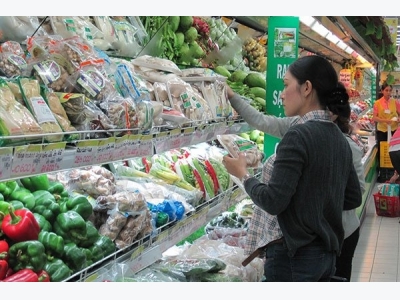Vegetables and fruits seen leading Vietnam agriculture

Consumers scrutinize vegetables at a supermarket - PHOTO: TRUNG CHANH
CAN THO – Vegetables and fruits are poised to emerge as the key growth driver of Vietnam’s agriculture in the future, heard an agriculture forum held in Dong Thap Province on December 18.
Speaking at the forum “Expanding Market for Fruits – Vegetables and Improving Logistics for Agriculture and Rural Development,” Le Thanh, head of the Institute of Vietnam Organic Agricultural Economics, said the global market for fruits and vegetables is expanding, thus creating a chance for Vietnam to develop the sector.
According to Thanh, global fruit and vegetable sales revenue reached US$250 billion in 2015, of which 63% came from fresh and 37% from processed fruits and vegetables. The global fruit and vegetable processing industry is expected to make US$317 billion in revenue in 2021.
Thanh said this sector in Vietnam holds great growth potential, with natural conditions favorable for growing fruit trees and vegetables.
The country has 863,000 hectares under fruit cultivation and 908,000 hectares under vegetable farming, mainly in the Mekong Delta and the Red River Delta.
Although there are only 145 fruit and vegetable processing companies in the country, their total exports in 2016 hit US$2.5 billion, up 44% year-on-year.
Thanh said many other countries invested in the fruit and vegetable processing industry years before Vietnam. However, the country can catch up by using modern technology.
Taking Lavifood JSC in Long An Province for example, Thanh said, the company has invested in a VND1.5-trillion (US$66 million) fruit and vegetable processing plant using Italian and German technologies. Its products are exported to many countries.
Addressing the forum, Prime Minister Nguyen Xuan Phuc pinned hopes on fruit and vegetable sector development, saying fruits and vegetables have become a major export earner of the country.
Fruit and vegetable exports amounted to US$3.5 billion last year, higher than that of rice and crude oil. However, the development of this sector is facing a number of challenges.
Phuc said farming productivity and product quality are still low. Therefore, the country should invest more in biotechnology and improve transplant quality.
Besides, unstable markets and high logistics costs have hampered the development of the fruit and vegetable production and processing industry. According to Phuc, logistics costs make up more than 20% of Vietnam’s gross domestic product (GDP), twice as high as the global average of nearly 12%.
Phuc told ministries and local authorities to improve logistics service and have favorable policies to facilitate the development of the sector.
Có thể bạn quan tâm
 High-tech farming model helps farmers escape poverty
High-tech farming model helps farmers escape poverty High-tech applications in agricultural development have been widely promoted in Hai Phong City. Along with projects by other economic groups
 VietGap standards to merit national rice brand
VietGap standards to merit national rice brand Rice products will be certified under the “Vietnam Rice” national brand if they are produced in accordance with VietGAP or GlobalGAP standards
 Rice export: Success exceeds expectations
Rice export: Success exceeds expectations Along with the traditional markets that increase rice imports as well as expand new export markets, while the export price of rice is higher than the previous